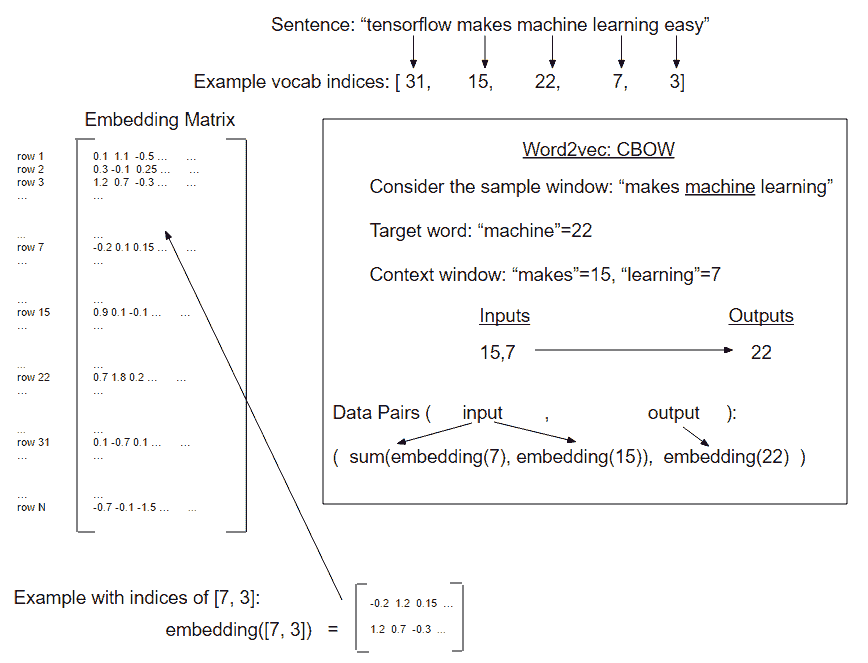# 使用 CBOW 嵌入
在這個秘籍中,我們將實現 word2vec 的 CBOW(連續詞袋)方法。它與`Skip-Gram`方法非常相似,除了我們預測來自環境詞周圍窗口的單個目標詞。
## 做好準備
在這個秘籍中,我們將實現 word2vec 的`CBOW`方法。它與`Skip-Gram`方法非常相似,只是我們預測來自環境詞周圍窗口的單個目標詞。
在前面的示例中,我們將窗口和目標的每個組合視為一組配對的輸入和輸出,但是使用 CBOW,我們將周圍的窗口嵌入添加到一起以獲得一個嵌入來預測目標字嵌入:

圖 5:如何在一個例子的窗口上創建 CBOW 嵌入數據的描述(每側窗口大小= 1)
大多數代碼都保持不變,除了我們需要改變我們創建嵌入的方式以及如何從句子生成數據。
為了使代碼更易于閱讀,我們已將所有主要函數移動到同一目錄中名為`text_helpers.py`的單獨文件中。此函數保存數據加載,文本正則化,字典創建和批量生成函數。除非另有說明,否則這些函數與使用 Skip-Gram Embeddings 秘籍中顯示的完全相同。
## 操作步驟
我們將按如下方式處理秘籍:
1. 我們將首先加載必要的庫,包括前面提到的`text_helpers.py`腳本,我們將把我們的函數用于文本加載和操作。然后我們將開始一個圖會話:
```py
import tensorflow as tf
import matplotlib.pyplot as plt
import numpy as np
import random
import os
import pickle
import string
import requests
import collections
import io
import tarfile
import urllib.request
import text_helpers
from nltk.corpus import stopwords
sess = tf.Session()
```
1. 我們要確保在開始保存之前存在臨時數據和參數保存文件夾。使用以下代碼檢查:
```py
# Make a saving directory if it doesn't exist
data_folder_name = 'temp'
if not os.path.exists(data_folder_name):
os.makedirs(data_folder_name)
```
1. 然后我們將聲明模型的參數,這與我們在上一個秘籍中對`Skip-Gram`方法所做的類似:
```py
# Declare model parameters
batch_size = 500
embedding_size = 200
vocabulary_size = 2000
generations = 50000
model_learning_rate = 0.001
num_sampled = int(batch_size/2
window_size = 3
# Add checkpoints to training
save_embeddings_every = 5000
print_valid_every = 5000
print_loss_every = 100
# Declare stop words
stops = stopwords.words('english')
# We pick some test words. We are expecting synonyms to appear
valid_words = ['love', 'hate', 'happy', 'sad', 'man', 'woman']
```
1. 我們已將數據加載和文本正則化函數移動到我們在開始時導入的單獨文件中,此文件在 github 倉庫中都可用, [https://github.com/nfmcclure/tensorflow_cookbook/tree/master/ 07_Natural_Language_Processing / 05_Working_With_CBOW_Embeddings](https://github.com/nfmcclure/tensorflow_cookbook/tree/master/07_Natural_Language_Processing/05_Working_With_CBOW_Embeddings) 和 Packt 倉庫, [https://github.com/PacktPublishing/TensorFlow-Machine-Learning-Cookbook-Second-Edition](https://github.com/PacktPublishing/TensorFlow-Machine-Learning-Cookbook-Second-Edition) 。現在我們可以打電話給他們我們也只想要包含三個或更多單詞的評論。使用以下代碼:
```py
texts, target = text_helpers.load_movie_data(data_folder_name) texts = text_helpers.normalize_text(texts, stops) # Texts must contain at least 3 words target = [target[ix] for ix, x in enumerate(texts) if len(x.split()) > 2] texts = [x for x in texts if len(x.split()) > 2]
```
1. 現在我們將創建我們的詞匯詞典,這將幫助我們查找單詞。當我們想要打印出最接近我們驗證集的單詞時,我們還需要一個反向字典來查找索引中的單詞:
```py
word_dictionary = text_helpers.build_dictionary(texts,
vocabulary_size)
word_dictionary_rev = dict(zip(word_dictionary.values(), word_dictionary.keys()))
text_data = text_helpers.text_to_numbers(texts, word_dictionary)
# Get validation word keys
valid_examples = [word_dictionary[x] for x in valid_words]
```
1. 接下來,我們將初始化我們想要擬合的單詞嵌入,并聲明模型數據占位符。使用以下代碼執行此操作:
```py
embeddings = tf.Variable(tf.random_uniform([vocabulary_size, embedding_size], -1.0, 1.0))
# Create data/target placeholders
x_inputs = tf.placeholder(tf.int32, shape=[batch_size,
2*window_size])
y_target = tf.placeholder(tf.int32, shape=[batch_size, 1])
valid_dataset = tf.constant(valid_examples, dtype=tf.int32)
```
1. 我們現在可以創建一種處理嵌入一詞的方法。由于 CBOW 模型添加了上下文窗口的嵌入,我們將創建一個循環并將所有嵌入添加到窗口中:
```py
# Lookup the word embeddings and
# Add together window embeddings:
embed = tf.zeros([batch_size, embedding_size])
for element in range(2*window_size):
embed += tf.nn.embedding_lookup(embeddings, x_inputs[:, element])
```
1. 我們將使用 TensorFlow 中內置的噪聲對比誤差損失函數,因為我們的分類輸出太稀疏,無法使 softmax 收斂,如下所示:
```py
# NCE loss parameters
nce_weights = tf.Variable(tf.truncated_normal([vocabulary_size,
embedding_size], stddev=1.0 / np.sqrt(embedding_size)))
nce_biases = tf.Variable(tf.zeros([vocabulary_size]))
# Declare loss function (NCE)
loss = tf.reduce_mean(tf.nn.nce_loss(weights=nce_weights,
biases=nce_biases,
inputs=embed,
labels=y_target,
num_sampled=num_sampled,
num_classes=vocabulary_size))
```
1. 就像我們在 Skip-Gram 秘籍中所做的那樣,我們將使用余弦相似性來打印離我們的驗證字數據集最近的單詞,以了解我們的嵌入如何工作。使用以下代碼執行此操作:
```py
norm = tf.sqrt(tf.reduce_sum(tf.square(embeddings), 1, keepdims=True))
normalized_embeddings = embeddings / norm
valid_embeddings = tf.nn.embedding_lookup(normalized_embeddings, valid_dataset)
similarity = tf.matmul(valid_embeddings, normalized_embeddings, transpose_b=True)
```
1. 要保存嵌入,我們必須加載 TensorFlow `train.Saver`方法。這個方法默認保存整個圖,但是我們可以給它一個參數來保存嵌入變量,我們也可以給它一個特定的名稱。在這里,我們給它的名稱與圖中的變量名稱相同:
```py
saver = tf.train.Saver({"embeddings": embeddings})
```
1. 我們現在將聲明我們的優化函數并初始化我們的模型變量。使用以下代碼執行此操作:
```py
optimizer = tf.train.GradientDescentOptimizer(learning_rate=model_learning_rate).minimize(loss)
init = tf.global_variables_initializer()
sess.run(init)
```
1. 最后,我們可以遍歷我們的訓練步驟,打印出損失,并將我們指定的嵌入和字典保存到:
```py
loss_vec = []
loss_x_vec = []
for i in range(generations):
batch_inputs, batch_labels = text_helpers.generate_batch_data(text_data, batch_size, window_size, method='cbow')
feed_dict = {x_inputs : batch_inputs, y_target : batch_labels}
# Run the train step
sess.run(optimizer, feed_dict=feed_dict)
# Return the loss
if (i+1) % print_loss_every == 0:
loss_val = sess.run(loss, feed_dict=feed_dict)
loss_vec.append(loss_val)
loss_x_vec.append(i+1)
print('Loss at step {} : {}'.format(i+1, loss_val))
# Validation: Print some random words and top 5 related words
if (i+1) % print_valid_every == 0:
sim = sess.run(similarity, feed_dict=feed_dict)
for j in range(len(valid_words)):
valid_word = word_dictionary_rev[valid_examples[j]]
top_k = 5 # number of nearest neighbors
nearest = (-sim[j, :]).argsort()[1:top_k+1]
log_str = "Nearest to {}:".format(valid_word)
for k in range(top_k):
close_word = word_dictionary_rev[nearest[k]]
print_str = '{} {},'.format(log_str, close_word)
print(print_str)
# Save dictionary + embeddings
if (i+1) % save_embeddings_every == 0:
# Save vocabulary dictionary
with open(os.path.join(data_folder_name,'movie_vocab.pkl'), 'wb') as f:
pickle.dump(word_dictionary, f)
# Save embeddings
model_checkpoint_path = os.path.join(os.getcwd(),data_folder_name,'cbow_movie_embeddings.ckpt')
save_path = saver.save(sess, model_checkpoint_path)
print('Model saved in file: {}'.format(save_path))
```
1. 這導致以下輸出:
```py
Loss at step 100 : 62.04829025268555
Loss at step 200 : 33.182334899902344
...
Loss at step 49900 : 1.6794960498809814
Loss at step 50000 : 1.5071022510528564
Nearest to love: clarity, cult, cliched, literary, memory,
Nearest to hate: bringing, gifted, almost, next, wish,
Nearest to happy: ensemble, fall, courage, uneven, girls,
Nearest to sad: santa, devoid, biopic, genuinely, becomes,
Nearest to man: project, stands, none, soul, away,
Nearest to woman: crush, even, x, team, ensemble,
Model saved in file: .../temp/cbow_movie_embeddings.ckpt
```
1. `text_helpers.py`文件中除了一個函數之外的所有函數都具有直接來自上一個秘籍的函數。我們將通過添加`cbow`方法對`generate_batch_data()`函數稍加補充,如下所示:
```py
elif method=='cbow':
batch_and_labels = [(x[:y] + x[(y+1):], x[y]) for x,y in zip(window_sequences, label_indices)]
# Only keep windows with consistent 2*window_size
batch_and_labels = [(x,y) for x,y in batch_and_labels if len(x)==2*window_size]
batch, labels = [list(x) for x in zip(*batch_and_labels)]
```
## 工作原理
此秘籍與使用 Skip-Gram 創建嵌入非常相似。主要區別在于我們如何生成數據并組合嵌入。
對于這個秘籍,我們加載數據,正則化文本,創建詞匯詞典,使用字典查找嵌入,組合嵌入,并訓練神經網絡來預測目標詞。
## 更多
值得注意的是,`CBOW`方法訓練周圍窗口的累加嵌入以預測目標字。這樣做的一個結果是來自 word2vec 的`CBOW`方法具有`Skip-Gram`方法缺乏的平滑效果,并且認為這對于較小的文本數據集可能是優選的是合理的。
- TensorFlow 入門
- 介紹
- TensorFlow 如何工作
- 聲明變量和張量
- 使用占位符和變量
- 使用矩陣
- 聲明操作符
- 實現激活函數
- 使用數據源
- 其他資源
- TensorFlow 的方式
- 介紹
- 計算圖中的操作
- 對嵌套操作分層
- 使用多個層
- 實現損失函數
- 實現反向傳播
- 使用批量和隨機訓練
- 把所有東西結合在一起
- 評估模型
- 線性回歸
- 介紹
- 使用矩陣逆方法
- 實現分解方法
- 學習 TensorFlow 線性回歸方法
- 理解線性回歸中的損失函數
- 實現 deming 回歸
- 實現套索和嶺回歸
- 實現彈性網絡回歸
- 實現邏輯回歸
- 支持向量機
- 介紹
- 使用線性 SVM
- 簡化為線性回歸
- 在 TensorFlow 中使用內核
- 實現非線性 SVM
- 實現多類 SVM
- 最近鄰方法
- 介紹
- 使用最近鄰
- 使用基于文本的距離
- 使用混合距離函數的計算
- 使用地址匹配的示例
- 使用最近鄰進行圖像識別
- 神經網絡
- 介紹
- 實現操作門
- 使用門和激活函數
- 實現單層神經網絡
- 實現不同的層
- 使用多層神經網絡
- 改進線性模型的預測
- 學習玩井字棋
- 自然語言處理
- 介紹
- 使用詞袋嵌入
- 實現 TF-IDF
- 使用 Skip-Gram 嵌入
- 使用 CBOW 嵌入
- 使用 word2vec 進行預測
- 使用 doc2vec 進行情緒分析
- 卷積神經網絡
- 介紹
- 實現簡單的 CNN
- 實現先進的 CNN
- 重新訓練現有的 CNN 模型
- 應用 StyleNet 和 NeuralStyle 項目
- 實現 DeepDream
- 循環神經網絡
- 介紹
- 為垃圾郵件預測實現 RNN
- 實現 LSTM 模型
- 堆疊多個 LSTM 層
- 創建序列到序列模型
- 訓練 Siamese RNN 相似性度量
- 將 TensorFlow 投入生產
- 介紹
- 實現單元測試
- 使用多個執行程序
- 并行化 TensorFlow
- 將 TensorFlow 投入生產
- 生產環境 TensorFlow 的一個例子
- 使用 TensorFlow 服務
- 更多 TensorFlow
- 介紹
- 可視化 TensorBoard 中的圖
- 使用遺傳算法
- 使用 k 均值聚類
- 求解常微分方程組
- 使用隨機森林
- 使用 TensorFlow 和 Keras
